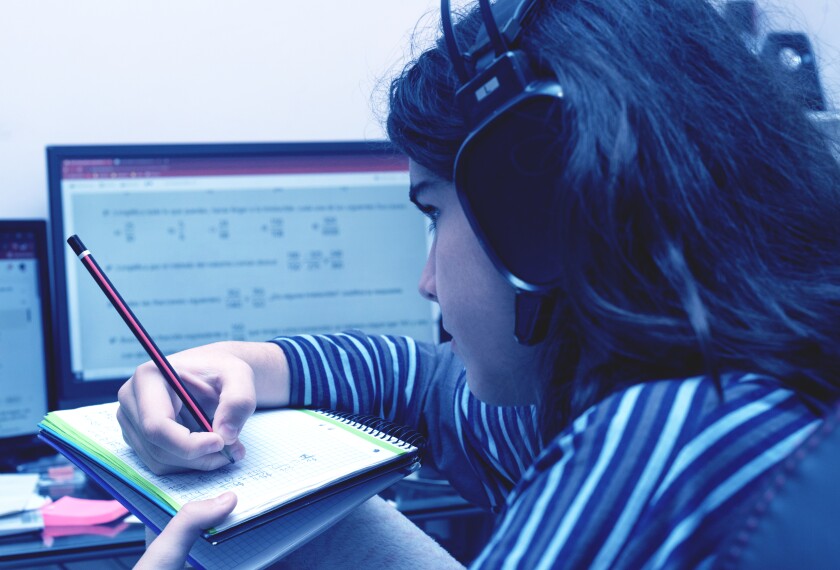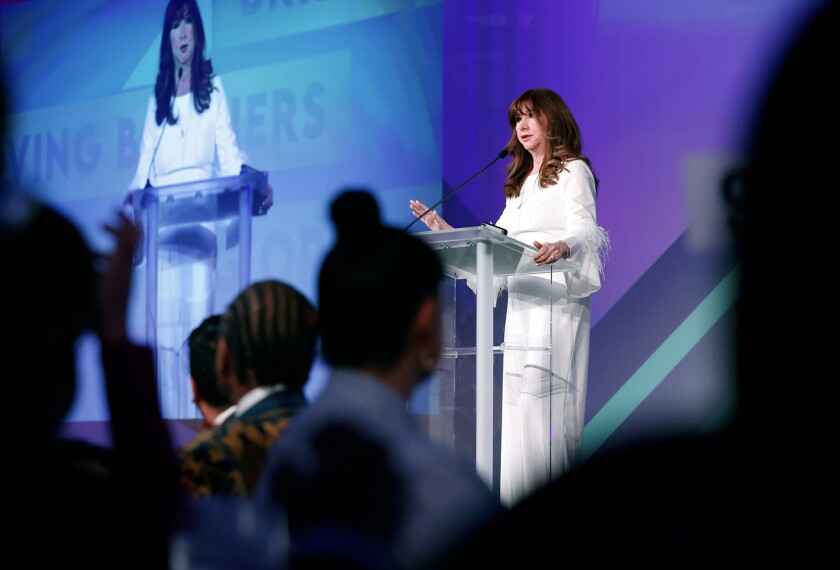Today’s post wraps up a three-part series on differentiation in the classroom.
‘I Always Plan Backward’
Luisana González is currently serving dual-language students in Illinois in a 5th grade classroom. She is in her 19th year of teaching and has previously taught K-5 multilingual students in a resource position, 2nd grade sheltered education, and 2nd grade dual language:
In my experience, some of the most important elements of differentiating instruction in the classroom occur before launching a unit, lesson, or learning activity. Timely and frequent assessment practices and planning are essential when delivering effective differentiated instruction. Providing differentiated instruction is a multilayered process that requires teachers to be informed and prepared to meet the readiness levels and linguistic, academic, and learning needs of all students.
It is certainly a big task that requires habitual and diverse processes that encourage student agency and voice. The ultimate goal is to plan instruction that takes into account different modalities to facilitate new learning. Pre-assessment helps the planning process, so that we are able to implement methods that will support students throughout the learning process in order to advance learning. Of course, assessments continue to be an integral part throughout a unit of instruction to ensure that the learning events and methods are tailored to meet the students’ needs as they make progress in a unit of instruction.
I always plan backward, beginning with the end in mind. What and where is the finish line, and how can I make sure that all students can understand the end goal and the steps to get there? The data that I acquire prior to the implementation of a unit through pre-assessment opportunities guide the road map to the finish line. The stops along the way are determined and modified throughout as I learn more about how students are responding to the planned learning events and experiences.
In simplest terms, I habitually attempt to provide differentiation opportunities that are tiered from the get go. The simplest ways to do this are providing appropriate scaffolds to advance and stretch learning, building in higher-order thinking and learning tasks to support students at their level, and carefully curating leveled texts and other learning resources that foster learning and meet students at their level to achieve their highest potential throughout.
While differentiating instruction may feel like an overwhelming task, it becomes an easier and more natural job when we become experts in our students and in our content/subject matter, learning goals, and objectives. When we clearly define what it is that must be accomplished and how we can achieve it, then differentiation becomes more logical and instinctive.
Some of the differentiation strategies that I have found to be most effective in my classroom are small groups, strategic pairings, flipped learning, chunking lessons, kinesthetic learning, cooperative learning structures, sentence frames and stems, advance organizers, thinking maps, student choice, tiered lessons or learning activities, levels of questioning, building thinking tasks, and inquiry projects.
Careful planning for differentiation takes a lot of work, and I have been most successful at it when I have included other colleagues and my students in the process. The challenges of teaching are a true balancing act, and improving in differentiating instruction is always a work in progress.
The ultimate goal of differentiation is to advance learning for all students regardless of their readiness levels, backgrounds, and academic, linguistic, and social-emotional needs. As long as we understand and value this, then we are definitely on the right track. We all know that one size does not fit all in the classroom, and when we engage everyone in a collective effort to move forward in the continuum of learning, while maintaining engaging and relatable learning events and activities, we will make progress toward achievement for all.
‘Content, Process, Product’
Latrese D. Younger is an education specialist in Virginia:
Differentiating instruction is all about altering the product, process, or content. When I taught ELA at the high school level, I remember feeling so frustrated by the multiple reading levels of the students within my urban classroom. My students’ reading levels ranged from primary to college level on a Lexile scale. I knew that if I was going to be an effective 9th grade ELA teacher, I would have to learn to make modifications to my lesson plans so that I wouldn’t have students either bored to death or feeling too far out of their zones of proximal development, which would inevitably lead to serious behavioral issues. I had to strike a balance in my classroom that honored all my learners and made each student feel seen and heard.
I’d come across this article on EdWeek that still may serve to demystify the differentiation process for teachers today. When you change the content, process, and product, you offer students the opportunity to access curriculum at their own pace.
Some of the easiest ways to do this in an ELA classroom is to provide students with an independent reading activity where only the Lexile scale is changed, not the content or topic. I used NewsELA to provide all students with an article on bubblegum, for example, printed at various Lexiles to accommodate all readers. A way to differentiate product and process at the same time is to give students choice boards where they are assessed on the same content but asked to demonstrate in various ways. For example, students could create a rap, poem, dance, essay, or podcast to demonstrate understanding of figurative language use in writing.
Giving all students the chance to demonstrate learning in a way that is meaningful, relevant, and reflective is truly what differentiates instruction. Taking into consideration various learning styles, schemas, and interests puts students at ease and encourages a sense of belonging. As educators, we affirm students and decry “they matter” when we intentionally design lessons that put their learning at the forefront, neglecting our own comfort (because differentiation can be messy and time consuming) for their well-being and greater outcomes.
What Differentiation Looks Like
Teresa Amodeo is an ESL/language-acquisition program coordinator for District 302 in Illinois. She has a master’s in literacy, with endorsements in ESL, middle school (language arts concentration):
Differentiating instruction means variation in teaching and instructing. Differentiation is taking lessons for a whole group and adjusting learning on the needs of the individual student or small group. Differentiation is creating an objective from the whole group’s focus for the learner or small group to achieve at their needs. Differentiation is providing assessments and assignments in multiple ways to pertain to the students’ or small groups’ unique learning styles. Differentiating highlights students as whole individuals with uniqueness, rather than a whole group.
Differentiating instruction looks like talking aloud on various ways to solve a math problem and emphasizing to the student or small group that doing the one that makes sense to them is all that matters as long as they get the same solution. Differentiation is taking a text in ELA and making it audible for those who listen better to texts, simplifying for those who need to just see the point, and not getting overwhelmed by the extra pieces, or providing a leveled text appropriate to the small group and withholding the same focus and/or objective as the whole group.
Differentiation looks like reading groups, math groups, grouped lab tables for science, all with the same focus of the whole-group content, with adjusted objectives to achieve that focus with the needs of the student or small group at the forefront.
One specific example is focusing on cause and effect in ELA as a whole group and then providing various objectives in small-group rotations. For instance, Group A works on identifying the cause and the effect in a leveled text through pointing or highlighting, with guided support or modeling by the teacher. Group B explains the cause and effect from a whole-group reading with a partner. And Group C creates cause and effect scenarios after a given scenario or text, with the main focus of the cause and effect standard.
Thanks to Latrese, Luisana, and Teresa for contributing their thoughts!
Today’s guests answered this question:
What does “differentiating instruction” mean to you, and what does it actually look like in the classroom?
In Part One, Isabel Becerra, Andrea Castellano, Kara Pranikoff, and Michelle Shory shared their ideas.
In Part Two, Marie Moreno, Ed.D., Jeffrey D. Wilhelm, and Cindy Garcia wrote their responses.
Consider contributing a question to be answered in a future post. You can send one to me at lferlazzo@epe.org. When you send it in, let me know if I can use your real name if it’s selected or if you’d prefer remaining anonymous and have a pseudonym in mind.
You can also contact me on Twitter at @Larryferlazzo.
Just a reminder; you can subscribe and receive updates from this blog via email. And if you missed any of the highlights from the first 12 years of this blog, you can see a categorized list here.
Disclaimer: The copyright of this article belongs to the original author. Reposting this article is solely for the purpose of information dissemination and does not constitute any investment advice. If there is any infringement, please contact us immediately. We will make corrections or deletions as necessary. Thank you.







